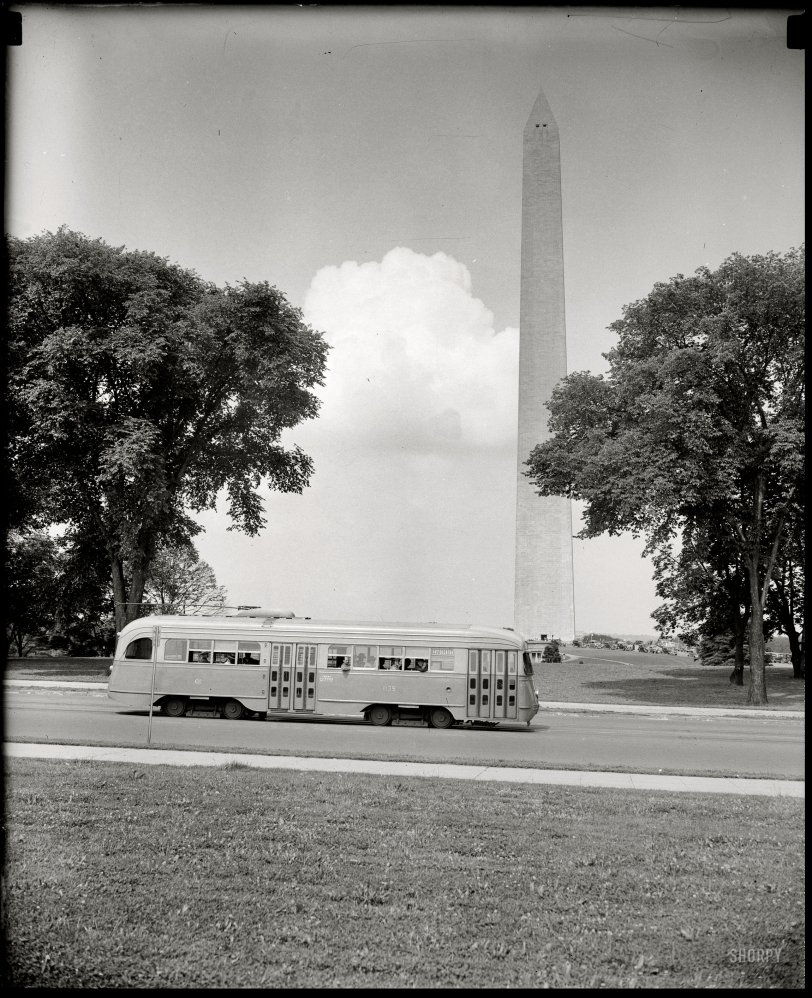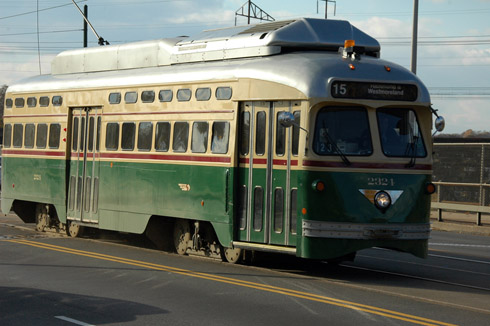


Framed or unframed, desk size to sofa size, printed by us in Arizona and Alabama since 2007. Explore now.
Shorpy is funded by you. Patreon contributors get an ad-free experience.
Learn more.

- What a headache!
- Baldwin 62303
- Baldwin VO-1000
- Cold
- No expense spared
- Tough Guys
- Lost in Toyland
- And without gloves
- If I were a blindfolded time traveler
- Smoke Consumer Also Cooks
- Oh that stove!
- Possibly still there?
- What?!?
- $100 Reward
- Freeze Frame
- Texas Flyer wanted
- Just a Year Too Soon
- WWII -- Replacing men with women at the railroad crossing.
- Yes, Icing
- You kids drive me nuts!
- NOT An Easy Job
- I wonder
- Just add window boxes
- Icing Platform?
- Indiana Harbor Belt abides
- Freezing haze
- Corrections (for those who care)
- C&NW at Nelson
- Fallen Flags
- A dangerous job made worse
Print Emporium
Streamliner: 1938

Washington, D.C., circa 1938. "Streamlined street car passing Washington Monument." Harris & Ewing Collection glass negative. View full size.
These still run in Philadelphia
PCC Cars
When I lived in St. Louis in 1950, I depended entirely on their wonderful public transport system to get around the city. They still had a lot of the old "growler" type streetcars and many buses, but there were many of the PCC type trolleys also. PCCs were faster and quieter than the buses, in fact, I have been waiting for a car on a downtown corner and did not hear the PCC car until I heard the "twang" of the trolley pole on the wire and found it only 25 feet away from the stop. Absolutely silent and smooth as silk. Out on the open track beside Forest park they would get up to what seemed like 50 mph. Maybe not that fast, but they really moved. The brakes, BTW, were a large electro magnet that fitted between the wheels and grabbed the railhead when stopping.
Desire
Sad but true, I have seen the bus named Desire. It ain't pretty.
Philly pickles
Philadelphia had the very same streetcars, painted green.
As a child I called them pickles, because that is what they most looked like.
Sometimes the connection to the overhead wires would break and the driver would walk out with a long pole and put it back on to get the car going again. They were running well into the 1980's. I never got to ride in one. I only saw them from the windows of the family car.
Buses may be more cost-efficient
But who ever heard of a bus named Desire?
Wow, Nice Shot!
So nice to see a streetcar cruising past the Washington Monument - hope they succeed in reintroducing them here, whether they be powered by underground conduits, or overhead wires.
Also, very, very nice to see the Washington Monument unencumbered by that ridiculous security hut at the base, which ruins the proportions and mars the simplicity of the great obelisk.
Tourmobiles
I'm not sure which is worse, these or the modern ubiquitous Tourmobiles.
So they're coming back!
A ridiculous, expensive, unsightly indulgence for train buffs and people who think they're "saving the planet." With the tab picked up by you, the taxpayer. Buses are much more cost-efficient and accomplish exactly the same thing.
PCC Fun Facts
PCC cars were in regular service in San Francisco till 1980, and are still operated, along with other historic cars, on the new "F Line" that runs along the Embarcadero and Market Street, as a tourist attraction connecting to the cable car routes. The PCC embodied many advances - rubber bushings and wheel cushions to reduce rattle and vibration, hypoid gears to eliminate noise, and later on, an all-electric model that eliminated the chugging compressor for air brakes. It was discovered that even standing passengers could deal with greater acceleration if it was smoother, so the old 14-point controller handle with its surges of power was replaced with an automated 99-step controller that produced seamless acceleration and braking. The design is widely recognized as a classic and was exported or licensed to Europe and South America.
Power Supply for Car
The car has a trolley pole in the down or retrieved position as it drew power from a conduit through a steel slot between the tracks. This system was required by local law and was also used in Manhattan, NYC. When car left D.C. limits, pole was raised to engage trolley wire power source and "plow" under car was disengaged as conduit power source ended. The conduit power system was much more expensive to construct and was only used where required by law.
What comes around...
The city of DC has just last week begun laying tracks for a modern streetcar system on H-street NE. As a homeowner there, I have been thinking about the history of streetcars in the city a lot lately. There is a federal law on the books banning overhead wires in much of DC. The law was passed sometime in the late 1800s.
The law continues to be a hurdle, as the kind of underground conduit system used on the old system is very expensive, difficult to maintain, unreliable, adds insurance liability to the system, and gets clogged up by snow in the winter. Before DC can send trains down the new tracks, it will most likely be necessary to have Congress make an exception to that old law, something that will no doubt be difficult to do, as DC has NO representation in Congress. Modern streetcar wires are very thin and unobtrusive, but progress towards alleviating the second-worst traffic congestion in the country (after LA) will likely be held up over politics.
I look forward to traveling to work above-ground like these people here in the next-generation modern air-conditioned street cars.
[The District is represented in Congress by delegate Eleanor Holmes Norton, a Democrat. - Dave]
Chevy Chase
I remember seeing these cars in the 1950s, when they pulled into Chevy Chase Center station. At that time they were painted light green and orange on white, the colors of D.C. Transit. At that station, there were a maze of overhead wires, quite impressive! A ride, as I remember, cost 35 cents.
Clang, clang!
My love for streetcars, cable cars, and trolleys knows no bounds. If not the fastest way of getting around, they're a damn sight faster than NYC buses in rush hour. (I'd love to know how streetcars compare carbon-footprint-wise with cars and buses.)
Which end is up?
Oh, there it is, just follow the arrows!
Underground
There is under the car, between the rails a slot in the pavement like a cablecar.
Washington, DC did not allow streetcar overhead, so when the cars crossed the city limits, the car would stop over a pit, the pole would be lowered, and a "plow" would be attached to the bottom of the car. Being the pitman must have been a great job in the winter.
You can see the slot between the rails here.
Old Number 1135
The car shown is No. 1135. A nearly identical car, 1101, is preserved at the National Capitol Trolley Museum in Maryland. Click for more info.
Although the trolleys got power from underground when in the District, the electric power aerial was raised when in the suburbs to draw power from overhead wires, as shown in the color photo.
The last Washington trolley ran in 1962, when the old D.C. Transit system converted to diesel buses. Now the D.C. suburb of Arlington County in considering bringing the trolley back to the Columbia Pike corridor. What was old is new again!
Up and Down
Power for the streetcars was underground only in central D.C. For example, the Wisconsin Ave line switched from underground to overhead somewhere around R Street. There was a worker who spent his shift in a hole in the ground who handled the "shoe" which picked up the underground and another who put up the overhead pickup. All this on the hill. Process reversed for cars coming back from Friendship Heights.
Something missing here?
OK, I give up, where is the overhead line that supplies power to the car? The "antenna" is there but it seems locked down. We still have a few cars of this vintage running (for special occasions only) here in Toronto.
[There's no overhead line because the power supply was underground. - Dave]
That's the PCC!
In the 30s, the heads of all the major urban transit operations got together and decided that they needed a more modern streamlined image than the old "trolley car," most of which were still boxy wood contraptions.
They set up a President's Conference Committee (PCC) to come up with new concepts and designs. The result was the PCC car -- all metal, quiet, sleek, fast and MODERN! Production started in the late 1930s, to be interrupted by the War of course. We LOVED riding them, feeling like we were Junior Buck Rogers in that streamliner.


























On Shorpy:
Today’s Top 5